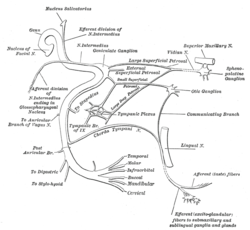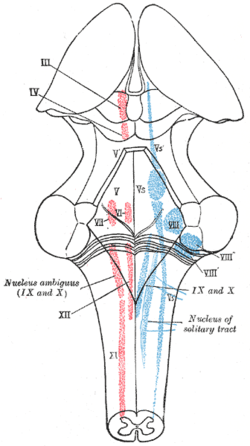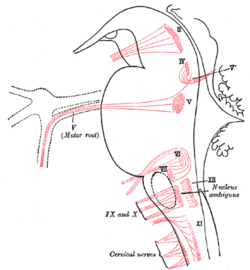Salivatory nuclei
The salivatory nuclei are the superior salivatory nucleus, and the inferior salivatory nucleus that innervate the salivary glands. They are located in the pontine tegmentum in the brainstem.[1] They both are examples of cranial nerve nuclei.
| Salivatory nuclei | |
|---|---|
 Plan of the facial and intermediate nerves and their communication with other nerves. (Nucleus salivatorius visible at upper left.) | |
| Details | |
| Identifiers | |
| Latin | nuclei salivatorius |
| NeuroNames | 590 |
| Anatomical terms of neuroanatomy | |
The superior salivatory nucleus innervates the submandibular gland and the sublingual gland and is part of the facial nerve[1]
The inferior salivatory nucleus innervates the parotid gland by way of the otic ganglion and forms the parasympathetic component of the glossopharyngeal nerve.[1]
Superior salivatory nucleus
The superior salivatory nucleus (or nucleus salivatorius superior) of the facial nerve is a visceromotor cranial nerve nucleus located in the pontine tegmentum. It is one of the salivatory nuclei.
Parasympathetic efferent fibers of the facial nerve (preganglionic fibers) arise according to some authors from the small cells of the facial nucleus, or according to others from a special nucleus of cells scattered in the reticular formation, dorso-medial to the facial nucleus – the superior salivatory nucleus.
Some of the preganglionic fibers travel along the greater petrosal nerve through the pterygoid canal, where they join the postsynaptic fibers of the deep petrosal nerve to become the nerve of the pterygoid canal. These fibers synapse in the pterygopalatine ganglion, whereupon the postganglionic, postsynaptic, efferent fibers travel to innervate the lacrimal gland and the mucosal glands of the nose, palate, and pharynx.
Preganglionic parasympathetic fibers are also distributed partly via the chorda tympani and lingual nerves to the submandibular ganglion, thence by postganglionic (vasodilator) fibers to the submandibular and sublingual salivary glands.
The term "lacrimal nucleus" is sometimes used to refer to a portion of the superior salivatory nucleus.[2]
Inferior salivatory nucleus
The inferior salivatory nucleus (or nucleus salivatorius inferior) is a cluster of neurons in the pontine tegmentum (dorsal part of the pons), just above its junction with the medulla. It is the general visceral efferent (GVE) component of the glossopharyngeal nerve supplying the parasympathetic input to the parotid gland for salivation.
It lies immediately caudal to the superior salivatory nucleus and just above the upper end of the dorsal nucleus of the vagus nerve in the medulla.
The preganglionic parasympathetic fibres originate in the inferior salivatory nucleus of the glossopharyngeal nerve. They leave the glossopharngeal nerve by its tympanic branch and then pass via the tympanic plexus and the lesser petrosal nerve to the otic ganglion. Here, the fibres synapse, and the postganglionic fibers pass by communicating branches to the auriculotemporal nerve, which conveys them to the parotid gland. They produce vasodilator and secretomotor effects.
Function
Parasympathetic input from fibers of the inferior salivatory nucleus stimulates the parotid gland to produce vasodilation and secrete saliva.
Additional images
 The cranial nerve nuclei schematically represented; dorsal view. Motor nuclei in red; sensory in blue.
The cranial nerve nuclei schematically represented; dorsal view. Motor nuclei in red; sensory in blue. Nuclei of origin of cranial motor nerves schematically represented; lateral view.
Nuclei of origin of cranial motor nerves schematically represented; lateral view.
References
This article incorporates text in the public domain from the 20th edition of Gray's Anatomy (1918)
- Gray, Henry (1918). Lewis, Warren H. (ed.). Gray's Anatomy (pdf) (20th ed.). Philadelphia PA: Lea & Febiger. ISBN 1-58734-102-6. Retrieved 7 June 2017.
- ancil-329 at NeuroNames
Bibliography
- Kiernan, John A. (2005). Barr's The Human Nervous System: An Anatomical Viewpoint. Lippincott Williams & Wilkins. p. 150. ISBN 0-7817-5154-3.